| Article ID | Journal | Published Year | Pages | File Type |
|---|---|---|---|---|
| 478336 | European Journal of Operational Research | 2013 | 9 Pages |
As a measure of overall technical inefficiency, the Directional Distance Function (DDF) introduced by Chambers, Chung, and Färe ties the potential output expansion and input contraction together through a single parameter. By duality, the DDF is related to a measure of profit inefficiency, which is calculated as the normalized deviation between optimal and actual profit at market prices. As we show, in the most usual case, the associated normalization represents the sum of the actual revenue and the actual cost of the assessed firm. Consequently, the corresponding profit inefficiency measure associated with the DDF has no obvious economic interpretation. In contrast, in this paper we allow outputs to expand and inputs to contract by different proportions. This results in a modified DDF that retains most of the properties of the original DDF. The corresponding dual problem has a much simpler interpretation as the lost profit on (average) outlay that can be decomposed into a technical and an allocative inefficiency component. In addition, an overall measure of technical inefficiency at the industry level is introduced resorting to the direction corresponding to the average input–output bundle.
► We show that the DDF-profit inefficiency has a no obvious economic interpretation. ► We introduce a new technical inefficiency measure by modifying the DDF. ► The new measure is related by duality to the lost profit on outlay. ► We measure and decompose profit inefficiency at the firm and at the industry level.
